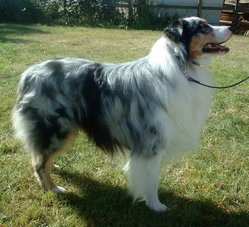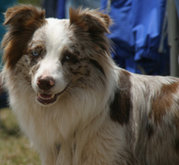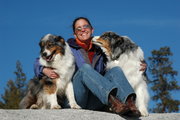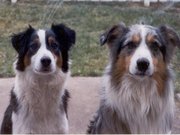Australian Shepherd
Dogs
Australian Shepherd
| Australian Shepherd |

Blue merle Australian Shepherd
|
| Alternative names |
| |
| Country of origin |
|
United States |
| Common nicknames |
| Aussie |
| Classification and breed standards |
|
FCI: |
Group 1 Section 1 #342 |
|
|
AKC: |
Herding |
|
|
ANKC: |
Group 5 - (Working Dogs) |
|
|
CKC: |
Group 7 - (Herding Dogs) |
|
|
KC (UK): |
Pastoral |
|
|
NZKC: |
Working |
|
|
UKC: |
Herding Dog Breeds |
|
| Not recognized by any major kennel club |
| This breed of dog is
extinct |
| Notes |
| |
The Australian Shepherd is a
working
dog that was developed—despite its name—in the
United States in the 19th century. The
dog, commonly known
as an Aussie, is popular in its native
California
and is growing in popularity in countries across the world.
Like many working breeds, the Aussie has considerable energy and drive and
usually needs a job to do. It often excels at
dog sports
such as frisbee
and dog
agility.
Appearance
The
coat comes in several colors—blue
merle, red merle, solid red, or solid black; all can occur with or without
white markings, tan (copper) points, or both. Dogs with tan and white along with
the primary color are usually called tricolor.
The breed's general appearance also varies greatly depending on the
particular line's emphasis. As with many working breeds that are also
shown in the
ring, there are differences of opinion among breeders over what makes an
ideal Australian Shepherd.
Reflecting the great variation that still exists in the breed, an Aussie can
stand between 18 and 23 inches (46 to 58 cm) at the
withers and
weigh between 35 and 70 pounds (16 to 32 kg). For show dogs, females should fall
in the lower heights and males in the higher ranges.
A hallmark of the breed is a short
bobbed or
docked tail
in countries where docking is permitted. Some Aussies are born with naturally
short bobbed tails, others with full long tails, and others with natural partial
bobs, where the tail is midlength and appears stubby. Most breeders dock the
tails when the puppies are born.
Temperament
 Red merle and white Aussie
Red merle and white Aussie
Because of the dog's origins, this breed is not for everyone. It is an
energetic dog that requires exercise and needs a job to do, whether it is
learning and practicing tricks, competing in dog agility, or any other
physically and mentally involving activity. It needs to run, full out,
regularly. It is usually a sweet and affectionate dog who is faithful to its
owners and is good with children, although its overwhelming instinct to work may
subvert its ability to function as a family dog, including chasing and nipping
at running children to herd them if not properly trained. Its protective
instinct and behaviors can be frightening to children, strangers, and small
animals. It was bred to guard stock and can be sometimes annoying with its
inclination to bark warnings about neighborhood activity, but it is not
generally an obsessively barking dog. It is intelligent, learns quickly, and
loves to play. This means that a bored, neglected, unexercised Aussie will
invent its own games, activities, and jobs, which to a busy owner might appear
to be hyperactivity in the house around fragile furnishings or involve the
destruction of yard and property.
 Aussies can be friendly and affectionate.
Aussies can be friendly and affectionate.
History
The Australian Shepherd's history is vague, as is the origin of its
misleading name. Most of the breed's antecedents most likely originated in the
Basque region near the Pyrenees Mountains between Spain and France.
Early European settlers took many of their herding dogs with them as they
emigrated to the eastern United States in the 19th century. Breeds included some
that are now extinct or that have merged into other breeds. These probably
included the English Shepherd, Dorset Blue Shag, Cumberland Sheepdog, Scottish
Collie, Glenwherry Collie, and Bouvier des Flandres, as well as dogs from
Germany and Spain. For many centuries, shepherds had more interest in dogs who
performed well when helping to manage flocks of sheep than they had in the
specific appearance of the dogs. As a result, over time, shepherds interbred
dogs that they believed would produce better workers for the given climate and
landscape. Terrain and
weather conditions in the eastern U.S. were similar to that of Europe, however,
so the existing imported breeds and their offspring worked well there.
In the
western states, conditions were quite different. In the primarily arid and
semiarid areas inhabited sparsely by early Spanish settlers, temperatures
reached extremes of hot and cold, and fields varied in altitude from sea level
into the higher, rougher Sierra Nevada and similar mountain ranges. A few
Spanish and Basque shepherds, their flocks, and their herding dogs came to
California with the Spanish missionaries and other settlers in the 18th and early 19th centuries.
 Black tricolor and blue merle tricolor Aussies.
Black tricolor and blue merle tricolor Aussies.
With the 1849
California gold rush, a massive migration occurred from the east coast to the
west coast, and along with the people came flocks of sheep and the eastern
herding dogs. But it was just as effective to bring sheep in by ship, and in
they came, including flocks from Latin America and other regions. Shepherds came
along with the flocks and also independently, from Latin America, Europe, and
Australia, along with their own herding breeds.
Dogs from Australia had already begun to be selected and bred for climates
and terrains that were often similar to
California.
As shepherds worked to develop dogs who could handle stock in harsh storms,
high arid heat, and chilling cold, and who could think on their own in
challenging terrain, reacting instantly to the movement of sheep and to their
handlers' commands, the type that became the Australian Shepherd was born.
The name remains somewhat of a mystery, however; the largest influx of
shepherds from Australia arrived in the early 20th century, well after the breed
had been established as a distinct type. It is possible that many of the
imported Australian herding dogs had merle coloring, which was also common in
the American Australian Shepherd breed, and so all merle herding dogs were
simply referred to as Australian. This remains conjecture.
Recent history
 Black and white (bicolor) Australian Shepherd stopping cows
Black and white (bicolor) Australian Shepherd stopping cows
Selective breeding for many generations focused on aspects of the dog that
enabled it to function as an effective stockdog in the American west. It had to
handle severe weather; have plenty of speed, athleticism, energy, and endurance;
and be intelligent, flexible, and independent while remaining obedient. The
Australian Shepherd remained more of a type than a
breed
until the 1950s, when they became popular as performing dogs in
rodeos. Their stunts and skills earned them places in several Disney films, including Run Appaloosa Run and Stub: The Greatest
Cowdog in the West.
The
Australian Shepherd Club of America (ASCA) was founded in 1957 to promote
the breed, and the National Stock Dog Registry became its official breed
registry the same year, which it continued until ASCA took over in the 1970s. In
the late 1970s, ASCA created a
breed standard, which described exactly how a dog should look and be
constructed (its
conformation). This was the first step in becoming a breed rather than a
type.
In the United States, the
AKC is the primary breed registry for purebred dogs. However, many Aussie
breeders felt that AKC put too much emphasis on conformation and not enough on
performance, so ASCA declined to join the AKC. Those breeders who felt that AKC
membership had its advantages split off from ASCA to form their own Australian
Shepherd club, the United States Australian Shepherd Association, created their
own breed standard, and joined the AKC in 1993. The decision about affiliation
with the AKC remains controversial, as it does with many performance breeds.
These dogs excel at many
dog sports,
especially herding,
dog
agility,
frisbee, and
flyball.
References
- Coile, Caroline. Australian Shepherds. Barron's, 1999.
ISBN 0-7641-0558-2
External links
Home | Up | Affenpinscher | Afghan Hound | Africanis | Aidi | Airedale Terrier | Akbash Dog | Akita Inu | Alano Español | Alapaha Blue Blood Bulldog | Alaskan Klee Kai | Alaskan Malamute | Alaskan Husky | Alpine Dachsbracke | American Bulldog | American Cocker Spaniel | American Eskimo Dog | American Foxhound | American Hairless Terrier | American Mastiff | American Pit Bull Terrier | American Staffordshire Terrier | American Staghound | American Water Spaniel | Anatolian Shepherd Dog | Appenzeller Sennenhund | Argentine Dogo | Artois Hound | Australian Bulldog | Australian Cattle Dog | Australian Kelpie | Australian Shepherd | Australian Silky Terrier | Australian Stumpy Tail Cattle Dog | Australian Terrier | Azawakh
Dogs, made by MultiMedia | Free content and software
This guide is licensed under the GNU
Free Documentation License. It uses material from the Wikipedia.
|




